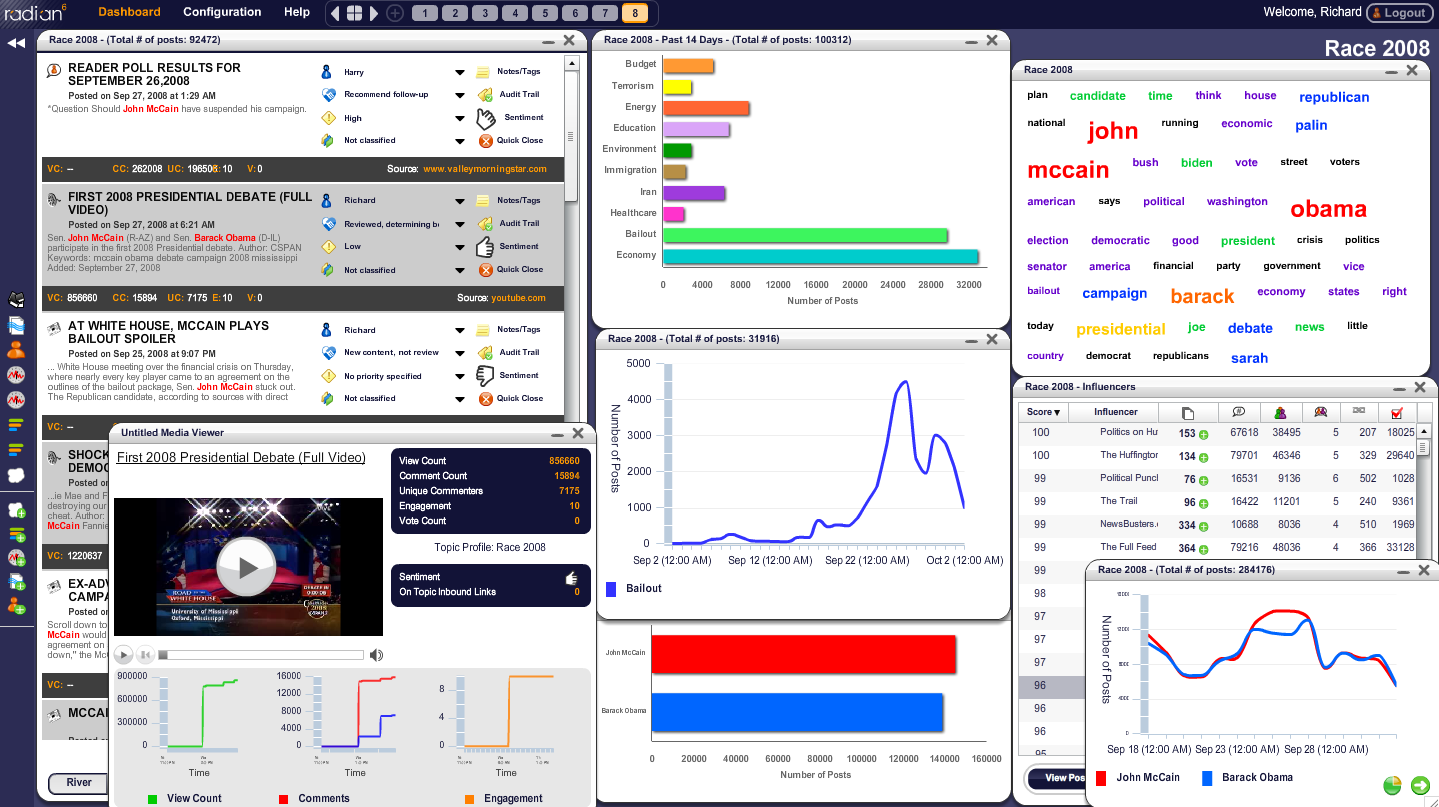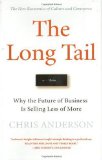PRMM Interview: Jason Falls Discusses Social Media and Communications
A couple of weeks ago, I met up with Jason Falls of Doe Anderson and Social Media Explorer. After a beautiful meal at Il Fornaio with Jason and his wife, we sat down for a quick video about social media and communciations strategies. Here is a summaryof this video.
Communications Strategy: Traditional and Social Media
* Communications strategies for traditional PR is typically one that looks at talking points and messages we want to communicate via traditional media
* Traditional media is about one-way communciations with the audience
* With social media, traditional media is no longer part of this as now you’re going direct to the consumer
* No longer is it one-way communications. It’s about how you can create a strategy to communicate these talking points in a conversational way
Different for B2B and B2C?
- Not necessarily as B2B is in between the two extremes of traditional media and social media
- Regardless if this is B2B or B2C, social media requires a conversation
- How can you be nimble in your conversations
Tweet this on Twitter
PRMM Interview with Jason Falls regarding social media and communications strategy by @csalomonlee: http://twurl.nl/a70p7g
Blocking Your Twitter Followers
 During Web 20 I had a very interesting conversation with John Welsh of UMB Live. He mentioned (and has a post) that he blocks anyone not directly related to social media and his direct interests from following his tweets. This is in direct contrast to the recent CNN and Ashton Kutcher race to 1 Million followers.
During Web 20 I had a very interesting conversation with John Welsh of UMB Live. He mentioned (and has a post) that he blocks anyone not directly related to social media and his direct interests from following his tweets. This is in direct contrast to the recent CNN and Ashton Kutcher race to 1 Million followers.
For John, this enables him to know exactly who everyone is and provides a higher quality community. While this makes sense I’m not sure about blocking everyone. In my case, I don’t mind who follows me as this doesn’t IMPACT me versus if I “followed” all of these folks.
What is you goal?
I think it comes down to what your goal is. For John having higher quality is important. For a celebrity like Ashton this provides a direct link to his fans. For me, my goal is to educate people on marketing, public relations and social media.
For B2B Businesses I think you have to strike a balance. I would recommend blocking any blatant “spam” accounts and being selective on who you follow.
But my competitors…
Some have asked about blocking competitors. While you can block them from following you, you can’t stop them from searching on you and getting those updates. In the end, Twitter is a public avenue for connecting with people and engaging in an open dialogue. I think private Twitter defeats that purpose.
If you’re concerned about competitive issues, then don’t use Twitter. That’s frankly what instant messaging and email are for.
Conclusions: Block with a strategy in mind
As with everything you need to fully consider your strategy for Twitter and how blocking followers with this. Furthermore, blocking may have a negative impact if you accidentally block someone from your target audience. I’m going to take the conservative approach. I will begin blocking anyone blatantly a spammer (britneyspearsbuzz watch out!) but will keep everyone else.
What do you think – to block or not block is the question?
Tweet This on Twitter
To make this easier, just cut and paste the following:
Should you block your Twitter followers by @csalomonlee: http://twurl.nl/z3mazo
All content copyright Cece Salomon-Lee, Creative Commons Attribution-Noncommercial-Share Alike 3.0 Unported, with the attribution: By Cece Salomon-Lee, PR Meets Marketing, and a link to the post.
Three Tips for Your YouTube Video
Over the past few weeks, I’ve been experimenting more with video. It’s visual and can communicate a lot in a short span of time. I want to share three tips that I’ve learned over the past few weeks for your http://www.YouTube.com/ videos.
The Quality Vs. Content Dilemma
There are two camps on the quality of the video versus the content. Some insist that the video be high-production quality while others (like me) believe that slighter lower quality with good content is fine. I prefer the latter because I’ve seen videos held up because of delays with production. By the time the video is “production quality,” you may have missed an opportunity to lead with quality content.
I argue that as long as you have quality content, your viewers are willing to sacrifice a little quality.
Engaging Spokesperson
When doing a video, the spokesperson is just as important as the content. You may have the best content but if the person is unable to deliver it convincingly and in an engaging way, people may stop the video and go elsewhere.
Distributing the Video
The last part is how to distribute your video. I’ve personally defaulted to YouTube and I believe that YouTube is becoming a place for business videos too. For those who may not want to watch the video, consider writing an accompanying post that summarizes the key points. Instead of a social media press release, I recommend issuing a press release that points to a page that has the video on your website alongside with other relevant content.
Conclusions
Since starting my new job, I haven’t had much time to devote to my blog. To me, video may be a way for me to capture my thoughts and introduce you to folks in the industry as well. Let’s see how this works. What do you think? Do you like the videos or prefer my written posts?
Side Note – Flip mini HD
So I just bought the Flip mini HD to post higher quality video while not breaking the bank. I like the little camera, but I thought I had uploaded a HD quality video. Because the Flip software doesn’t have many editing options,I imported the video to the Windows Movie Maker program that came with my computer. The video played well on my computer but I lost something as it was uploaded. I think I may take a page from my friend John Welsh, who just records and posts the whole video without any editing.
Revisiting PR Firms and Social Media
The response to my post on which PR firms hasd a social media presence was, well, more than I expected. My post received 66 comments while Jeremiah Owyang’s post had 47 comments. When reviewing the comments, you could see two audiences emerging:
– those who believe that you have to practice what you preach and
– those who believed that corporate presence wasn’t as important as much as the work that was done for clients and the individual participation within those firms
Regardless of which camp you belong to, the discussion resulted in the creationing of a wiki to allow PR firms to proactively update their profiles. To the A few firms that did proactively update their profilesm thank you. To those who haven’t yet, why not?
Overall, here is the breakdown:
– 109 firms are on the list
– 50 firms have blogs
– While 38 firms have corporate Twitter profiles, 5 firms deferred to individuals versus corporate Twitter. In total, 13 firms had individuals participating on Twitter.
– 47 firms had a Facebook presence, while 38 had LinkedIn
– 16 firms have started using Flickr, YouTube and Second Life
So, who else is missing from the list? Go to http://prfirmssocialmedia.pbwiki.com to make the udpates.
Measuring The Cost of Bad or Good Online Reputation
I received this question from Nathalie Seoteman after she read my free ebook on using social media:
How [can you] calculate the value of a company’s online reputation and (marketing) PR 2.0 efforts? What did these activities produce, put in figures and – preferably – in euro’s/dollars? I would like to include both the reputation damage that has been diverted and the positive/negative/neutral online coverage that has been created.
This raises an interesting and very complex question. There will inevitably be tangible and intangible ways to measure the value.
Measuring Positive and Negative Reactions
Assuming that you’re using a tool like Trackur, Radian6 or just Google alerts to track your coverage, the first thing you have to segment the coverage by what Radian6 calls sentiment – negative, neutral or positive. Once you’ve done this for media coverage, video responses, Twitter responses, blogs postings and more, you can get a visual representation of the sentiment over time.
The question then is how do you assign a monetary value to this. One way is to use ad equivalence, which is how much would it have cost you to advertise in a magazine for the same space. The obvious drawback is that this will not cover a significant portion of your coverage and you have to do the time consuming research to find the ad values. But let’s assume that this works for 40% of the videos, blogs and media coverage out there. How do you measure the remaining 60%?
The Value of a Single Customer Won or Lost
I am assuming that you have a sense of your sales pipeline and what the average deal size (let’s keep this simple, ok? =). If you delved into the content of what is being said, how many would say they would 1) hire your company; 2) never work with your company again or 3) are neutral.
I’m making a huge assumption that each person is a potential customer regardless of their company affiliation and title. For example, there are over 589,000 fans on the Skittles Facebook page. If I assumed that each person bought at least one Skittles product that cost $0.75, then the potential value would be $448,500.
You can then do the same with your business: positive = gain average deal size, neutral = zero, negative = costs you average deal size
Conclusions: Not an Exact Science, Yet
I admit that I am ignoring the relative influence and weight of differing outlets, people or prominence of coverage. I also know that not everything can be easily dissected into the three sentiments I highlighted above. But frankly, I didn’t want to turn this posting into an essay ?
While technology is catching up to help automate the process, I believe that there is still a very manual process involved to evaluate the coverage, put it into the appropriate bucket and then assign a value to it. Hence, I recommend that you start simply – take the most simple measurement and build upon it over time. Otherwise, you may find yourself spending more time assembling reports about your online reputation versus managing it directly.
In the end, there is no right answer for measuring the value of bad or good online reputation management. I hope the above provides a starting point for those seeking to calculate this value.
I would love to hear of how others would go about calculating the value of bad and good online reputation.
The “formulas”
Positive Ad Equivalence – Negative Ad equivalence = Total Ad Equivalence
Potential Customer Deal Won – Potential Customer Deal Lost = Value of Potential Customer Deal
Total Ad Equivalence + Potential Customer Deal = Total Value of Positive/Negative Online Reputation
Online Reputation Management: Radian6
Online reputation management is an increasingly complicated process with the prevalence of online media, offline media, and social media. I previously wrote a post about Trackur and had the opportunity to see a demo of Radian6‘ solution. I was very impressed with the sophistication of what Radian6 has put together.
General Capabilities
Radian6 seems to have a very comprehensive search capability through different types of media. The results are presented by publication date. I liked how the service provides a social profile of each media outlet, such as blogger info or Twitter followers/following/updates. You can quickly scan the results to determine “influence weight” (more on that below). You can also set up different searches to monitor your company, competitors and different topics.
Share of Conversation
I liked how Radian6 is able to pull info to create what they call share of conversation. It’s similar to “influence” but goes deeper to determine your share of voice on particular topics. Radian6 will do one time topic pull of the past 6 months to create a baseline. This way, you can track which how your marketing, PR and social media activities have impacted the company’s online reputation over time.
The basics are:
– River of news – this is all the mentions that you’ve received based on the criteria you set up for the search
– Influence widget – you have the ability to weight different criteria, for example number of inbound links, (what are other criteria).
– Trending – you can view the data in aggregate to spot trends. For example, did a free eBook create a spike on Twitter with retweets or a press release increase the online mentions through your news distribution.
– Conversation clouds – you can further drill down to see conversation clouds (similar to tag clouds), which allow you to sense keywords around a particular topic, company, etc.
– Reporting – the information can then be exported into different formats. You can send out a dashboard report and two of the widgets twice a day.
CRM Management
I like how Radian6 has incorporated a CRM flow to manage possible sales leads. For example, a dashboard is created to track key phrases, such as “online management tool”. Depending on the context, the lead generation manager can review and assign certain items to sales people. That is how Radian6 first identified me as a possible lead after my post about Trackur.
There is then an audit trail to determine the status of assigned items. While this isn’t linked to a larger CRM system like Salesforce, this is a nifty function to have for marketing and sales. It provides accountability and a steady source of prospective leads from multiple sources. Imagine that!
Conclusions
While the pricing is only a few hundred a month, it is more appropriate for larger companies or agencies (PR and marketing consultancies). The former can absorb the minimal cost while the latter will pass it on to their clients. SMBs or start-ups with tighter budgets may opp to forgo this in favor of other programs.
With all the ways the data can be viewed, I would be interested in seeing an executive dashboard that is a high-level breakdown on how a company’s share of conversation has evolved overtime. And if there was a way for a marketer to assign value to different campaigns, track the progress of “conversation” and then calculate ROI, that would be very interesting indeed.
Quick Overview:
Accuracy: As this was a demo, I cannot determine the level of accuracy. With that said, I do give Radian6 kudos for incorporating a variety of media types.
Ease of Use: 5 out of 5
Cost: Reasonable for companies, wished there was SMB Pricing. Non-profit pricing is available.
Response to Comments regarding "Would YOU Trust a PR Firm without a Social Media Presence with Your Social Media Programs"
There has been quite a bit of discussion from the original post and on a post by Jeremiah Owyang titled “Walking the Talk: Some Agencies and Vendors Demonstrate Social Media Prowess,”. I honestly didn’t think that my initial effort would generate such discussion, which I think provides a lot of fodder for thought.
I do want to provide my perspective on one aspect of Jennifer Leggio’s comment:
Client service comes first, always. Yes agencies should strive to have a presence of their own but not having a presence on Twitter or LinkedIn for their corporation is not a good measurement — at all.
When reviewing Jennifer Leggio’s post “Is ‘social PR’ for real?”, this paragraph resonated with me:
Agencies need to work hard to ease their clients’ or potential clients’ minds by showing hard metrics of how social programs have worked for other clients. There is also more justifiable pressure on marketers as a whole to demonstrate ROI from social media programs. Clients should start requiring these types of ROI metrics or case studies and not take “this is a new practice” as a valid excuse for the agencies not having proof points. The agency at the very least should be able to show how it’s built its own brand / the brand of its people through social media.
I do agree with the position that a PR agency having a social media presence is not necessarily a barometer of how that agency can deliver results for clients using social media. However, I will argue that an agency’s ability to use these tactics/strategies to build awareness and industry expertise demonstrates understanding of the pressures that clients face and their objectives. This includes increasing incoming sales leads, communicating with key customers, building thought leadership, reaching key audiences, etc.
Besides this particular point, I want to add the following:
-
I recognize that individual contributors are just as important as corporate brands. I will still assert that corporate brands will be just as important for establishing brand awareness and thought leadership
-
With that said, how one participates in social media can be dictated based on one’s audience and goals. I strongly believe that having a presence in the right avenues helps to drive an agency’s lead generation efforts
-
Since I was laid off, I decided to do this research out of curiousity. I knew it would take time and spent a several hours over a two week period to “research” the original list. As I was doing this myself, I acknowledge that I may have missing or incorrect information. As such, I appreciate those who have provided updates in comments or emails to me. I have updated the table accordingly.
And finally, as this endeavor is much bigger than I originally anticipated, I have set up a public wiki for agencies and the community to make updates directly.
About
Favorite Service
Recent Comments
- on Going Virtual Isn’t Necessarily the Answer to Replacing Your Physical Events
- on Going Virtual Isn’t Necessarily the Answer to Replacing Your Physical Events
- on Going Virtual Isn’t Necessarily the Answer to Replacing Your Physical Events
- on Going Virtual Isn’t Necessarily the Answer to Replacing Your Physical Events
- on Going Virtual Isn’t Necessarily the Answer to Replacing Your Physical Events
Ads by Google
Favorite Books
Marketing Blogs
PR Blogs
- KD Paine's Measurement Blog
- Micro Persuasion
Virtual Events & Meetings Blogs
- Cisco Virtual Environments
- It's All Virtual
- The Webinar Blog
- Virtual Edge Institute

 Follow
Follow

 Cece Salomon-Lee is director of product marketing for Lanyon Solutions, Inc. and author of PR Meets Marketing, which explores the intersection of public relations, marketing, and social media.
Cece Salomon-Lee is director of product marketing for Lanyon Solutions, Inc. and author of PR Meets Marketing, which explores the intersection of public relations, marketing, and social media. 


